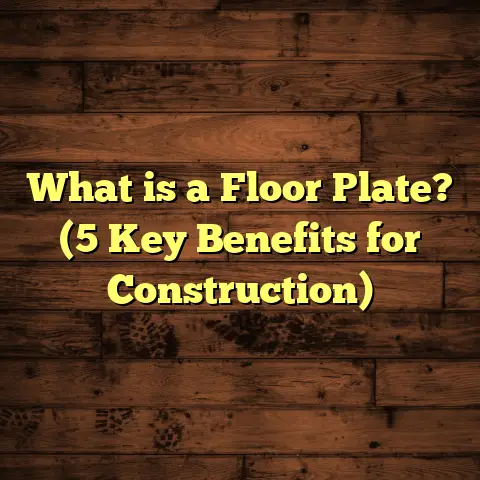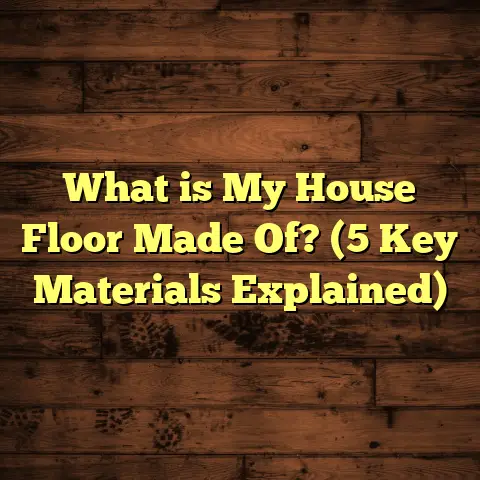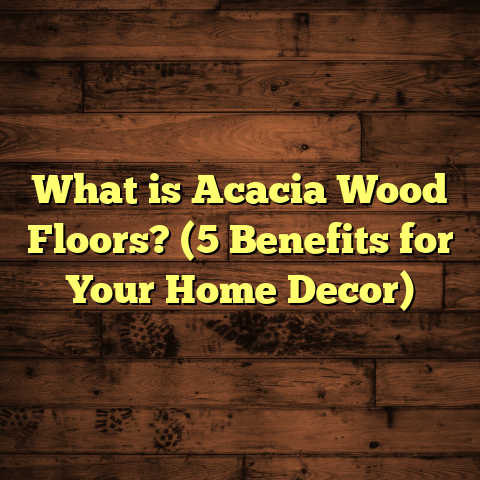What is Polymer Flooring? (5 Benefits for Your Next Project)
What if you could install a floor that resists everything life throws at it—spills, heavy foot traffic,
harsh chemicals—and still look fantastic years later without all the fuss of refinishing or replacing?
Sounds almost too good to be true. That’s exactly what got me hooked on polymer flooring when I first
started working as a flooring contractor. Over time, I’ve seen how this material can completely change
the game in both residential and commercial projects.
What is Polymer Flooring?
Let’s start with the basics. Polymer flooring refers to a group of synthetic coatings created from
materials like epoxy, polyurethane, and methyl methacrylate (MMA). These coatings are applied as
liquids and cure chemically to form a solid, seamless layer over a base surface—usually concrete.
Unlike traditional flooring options like tile or wood planks, polymer floors don’t have joints or grout
lines. This seamlessness makes them incredibly strong and easy to clean.
The main types of polymers used in flooring include:
- Epoxy: Known for its toughness and chemical resistance.
- Polyurethane: More flexible and UV-stable, suitable for areas exposed to sunlight.
- MMA: Cures very quickly, good for fast project turnaround.
How Polymer Floors Work
When applied, polymer coatings chemically bond with the concrete substrate. The reaction hardens
the material into a tightly linked matrix that resists abrasion and impacts. Because it flows as a liquid
before curing, it fills cracks and uneven spots, creating a smooth, continuous surface.
I remember my first polymer flooring job vividly—a small local brewery wanted floors that could handle
heavy foot traffic, frequent cleaning with harsh detergents, and occasional chemical spills from brewing
processes. We chose epoxy polymer flooring for its chemical resistance and durability. After installation,
the owners reported no damage even after months of intensive use.
Common Applications
Polymer flooring is popular in many settings:
- Industrial warehouses
- Commercial kitchens
- Garages and workshops
- Hospitals and laboratories
- Retail stores and showrooms
- Residential basements and garages
This versatility is one reason I often recommend polymer floors to clients with demanding needs.
The Science Behind Polymer Flooring Durability
Let’s get a little technical but in a way that’s easy to grasp. The secret behind polymer flooring’s durability
is its molecular structure. When the resin (polymer base) mixes with hardeners or catalysts during installation,
a cross-linking chemical reaction happens. This creates an interwoven network of molecules that lock together.
Here’s why that matters:
- High Compressive Strength: Polymer floors can handle heavy loads without cracking. For example,
epoxy floors have compressive strengths often exceeding 7,000 psi (pounds per square inch). To put this
in perspective, concrete typically ranges from 3,000 to 5,000 psi. - Abrasion Resistance: Thanks to this molecular network, polymer floors resist scratches and surface wear.
I’ve seen floors in busy warehouses last years without visible damage. - Chemical Resistance: The dense molecular bonds prevent chemicals from penetrating the surface, which
means acids, oils, solvents, and detergents won’t stain or degrade the floor easily. - Flexibility: Materials like polyurethane provide slight elasticity, which helps floors absorb shocks and resist
cracking under temperature changes or heavy impact.
Real Numbers That Impress
According to a report by the International Concrete Repair Institute (ICRI), well-installed epoxy polymer floors
can last 15–20 years with moderate foot traffic and proper maintenance. Maintenance costs tend to be 30% lower
than tile or wood floors over the same period because there’s no need for grout repairs or refinishing.
A case study I was involved in with a pharmaceutical company confirmed these benefits firsthand. They switched
from ceramic tiles to epoxy polymer flooring across 5,000 sq ft of lab space. After 3 years, their maintenance team
reported zero cracks or stains despite exposure to acids and solvents daily.
Five Benefits That Make Polymer Flooring Stand Out
1. Exceptional Durability
One of the biggest reasons I recommend polymer flooring is how tough it is. It can withstand impacts from dropped tools,
heavy foot traffic from thousands of employees daily, and even rolling loads like forklifts without damage.
At a manufacturing plant I worked on recently, they replaced worn-out concrete with an epoxy polymer floor. This floor
now handles large machinery moving across it daily without chipping or cracking.
If you’re tired of repairing or replacing floors every few years due to damage or wear, polymer flooring offers peace of mind.
2. Low Maintenance — Save Time & Money
Cleaning polymer flooring is incredibly simple. Since there are no grout lines or seams where dirt can hide, sweeping and mopping
are usually enough.
I’ve had clients tell me their janitorial staff spends half the time cleaning polymer floors compared to previous tiled or wood floors.
For example, in a busy restaurant kitchen renovation I did last year, kitchen staff mentioned how easy it was to wipe spills immediately.
No staining or discoloration meant less scrubbing and fewer chemicals needed.
3. Design Flexibility & Aesthetic Appeal
Here’s where polymer floors get fun. You’re not limited to boring gray concrete anymore. Polymeric materials come in many finishes:
- Glossy or matte
- Solid colors or multi-color blends
- Textured surfaces for slip resistance
- Embedded chips or metallic swirls for artistic effects
I once helped a client design an eye-catching retail showroom floor using colored epoxy flakes embedded in a translucent base coat. The result was both durable and visually impressive.
4. Chemical & Stain Resistance
If your space deals with oils, acids, or solvents regularly—like automotive shops or labs—polymer floors can save you headaches.
In one garage project I led, mechanics complained about old floors absorbing oil stains that were impossible to remove. Switching to an epoxy coating stopped staining completely.
According to research published by the Flooring Contractors Association (FCA), chemical spills on polymer floors require 60% less cleanup time than on standard concrete surfaces.
5. Fast Installation & Minimal Downtime
Time really matters when you renovate busy spaces like offices or shops. Polymer flooring cures faster than you might think.
For instance:
- Epoxy typically cures within 24–72 hours.
- MMA can cure within 2–4 hours.
- Polyurethane varies but usually finishes curing within 2 days.
When I installed an MMA floor in a retail store last year, we finished the entire project over a weekend so the business could open Monday morning fresh and ready.
My Step-by-Step Approach to Using Polymer Flooring
Having installed dozens of polymer floors over the years, I developed a workflow that ensures great results every time:
Step 1: Surface Assessment & Preparation
This is where many projects face challenges. Polymer floors rely on bonding tightly to their substrate—usually concrete.
I always inspect for cracks, moisture issues, oil contamination, or loose particles before starting.
Sometimes grinding or shot-blasting is necessary to roughen the surface for better adhesion.
In one hospital project, we used moisture meters extensively to check if the slab was dry enough before installing polyurethane coatings.
Step 2: Choosing the Right Polymer System
Not all projects require the same type of polymer. Here’s how I decide:
- Heavy industrial? Epoxy with high solids content.
- Outdoor areas? Polyurethane for UV resistance.
- Fast turnaround? MMA coatings.
- Need texture? Add anti-slip aggregates during installation.
Step 3: Installation Process
Installation usually involves:
- Priming the surface
- Applying base coats evenly with rollers or squeegees
- Adding decorative flakes or textures if desired
- Applying top coat for gloss and protection
Temperature and humidity must be controlled during installation for proper curing.
Step 4: Curing & Inspection
Once applied, curing times vary depending on material and conditions.
I always schedule inspections post-curing to check adhesion strength and look for defects like bubbles or pinholes.
If any issues arise, corrective measures like light sanding or touch-ups are done before handing over.
Maintaining Your Polymer Floor: Tips That Work
Maintenance is straightforward but important for longevity:
- Sweep daily to prevent grit scratches.
- Mop weekly with neutral pH cleaners.
- Avoid harsh chemicals like bleach or ammonia.
- Quickly clean spills.
- Use protective pads under furniture legs.
- Reapply topcoat every few years if desired for shine and extra protection.
I once had a client call me five years after installation asking if their epoxy floor needed refinishing. The answer was no—the floor still looked fantastic thanks to proper care.
Real Projects & Lessons Learned: My Personal Stories
Brewery Floor That Took It All
The brewery job I mentioned earlier taught me a lot about chemical resistance. Brewing acids and alcohol vapors didn’t harm the epoxy floor at all after months of exposure. The smooth surface also made cleanup fast after spills.
Daycare Room That Stayed Safe & Clean
A daycare center hired me to install polyurethane flooring in their playroom. Kids drop toys all day long; spills are constant. The floor resisted scratches and stains beautifully while providing a safe anti-slip surface that parents loved.
Garage Transformation That Lasted Years
A homeowner wanted a garage floor that wouldn’t crack or stain from oil leaks. We chose epoxy with decorative flakes for aesthetics too. Five years later, the floor still looks brand new despite harsh conditions.
Cost Breakdown & How I Use FloorTally for Estimates
Budgeting is often the trickiest part of any flooring project. Costs depend on:
- Material type (epoxy vs polyurethane vs MMA)
- Thickness required (thicker coats cost more)
- Surface prep complexity
- Area size
- Labor rates by region
- Decorative elements
That’s where FloorTally comes in handy for me. It lets me input all these variables quickly and get an instant estimate based on local prices.
For example:
| Project Type | Material | Estimated Cost (per sq ft) |
|---|---|---|
| Residential Garage | Epoxy | $7 – $12 |
| Commercial Kitchen | Polyurethane | $10 – $15 |
| Retail Showroom | Decorative Epoxy | $12 – $18 |
FloorTally also factors in waste percentages so I’m not caught short on materials. This tool saves me hours compared to calling multiple suppliers manually.
Having accurate estimates helps me advise clients realistically—no sticker shock later on in the project.
Frequently Asked Questions About Polymer Flooring
Q: Can polymer floors be installed over existing tiles?
A: Often yes, but surface prep is critical. Tiles must be sound and free of contaminants; sometimes existing tiles need removal for best results.
Q: How long does installation take?
A: Typically between 1–3 days depending on area size and material used. MMA can be done faster if needed urgently.
Q: Are polymer floors slippery?
A: They can be slippery when wet if smooth finish is used. Adding anti-slip aggregates during installation solves this problem easily.
Q: How resistant are they to UV damage?
A: Polyurethane polymers have excellent UV resistance; epoxy can yellow over time if exposed directly to sunlight unless treated with UV inhibitors.
Q: What is the lifespan of polymer flooring?
A: With proper installation and maintenance, expect 10–20 years or longer depending on use conditions.
Wrapping Up My Thoughts on Polymer Flooring
From my hands-on experience installing these floors in different environments, I can confidently say polymer flooring offers an impressive combination of durability, style flexibility, ease of maintenance, chemical resistance, and quick installation time.
Whether you’re renovating your home garage or outfitting an industrial warehouse, considering polymer flooring might save you money and hassle down the road while giving you exactly the look and performance you want.
Got questions about your specific project? Curious about which polymer system fits best? Let’s chat—I’m here to help you make smart flooring choices!





